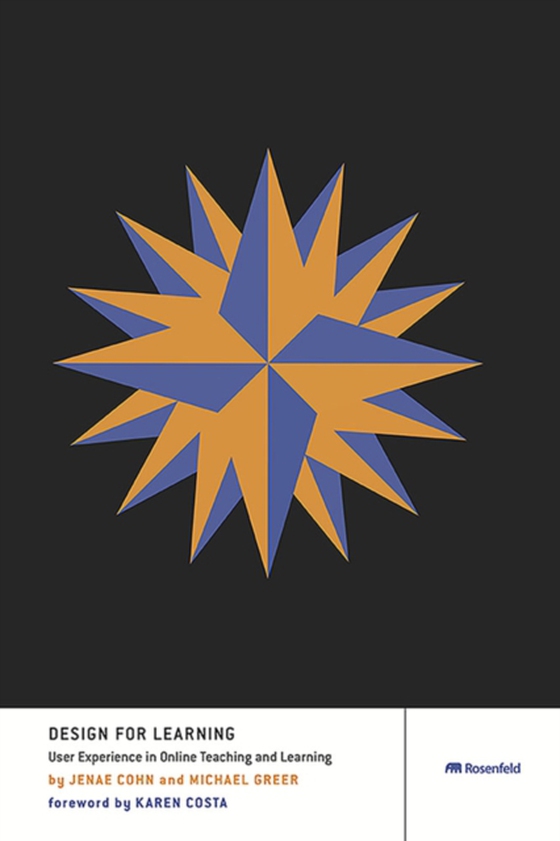
Design for Learning e-bog
348,37 DKK
(inkl. moms 435,46 DKK)
Online learning can be so dullor not!Enter Jenae Cohn and Michael Greer, experienced authors andteachers, who decided it was time to take on the challenge of making online learning more interesting and compellingfor students. So, they met in a Zoom call, contacted Rosenfeld Media, and wrote this book, Design for Learning: UserExperience in Online Teaching and Learning (many Zoom calls later). T...
E-bog
348,37 DKK
Forlag
Rosenfeld Media
Udgivet
25 juli 2023
Genrer
AKP
Sprog
English
Format
pdf
Beskyttelse
LCP
ISBN
9781959029038
Online learning can be so dullor not!Enter Jenae Cohn and Michael Greer, experienced authors andteachers, who decided it was time to take on the challenge of making online learning more interesting and compellingfor students. So, they met in a Zoom call, contacted Rosenfeld Media, and wrote this book, Design for Learning: UserExperience in Online Teaching and Learning (many Zoom calls later). The book is structured to teach online learning in such a way that anyone can follow its practices and create a dynamic educational presentation. Chapters cover everything fromlearning about your learners and setting learning goals to building connections with learners and giving them feedback. In addition, the authors dive into the nitty-gritty details of creating online courses, including takeaways at the endof each chapter and easy-to-follow examples throughout.I particularly appreciate how thoughtful Jenae and Michael are about considering the experience from the learners point of view and theemphasis they put on learner agency.Julie Dirksen, Author, Design for How People LearnTogether, Jenae Cohn and Michael Greer have years of experience designing and producing online courses for students. They wanted the tone of their book to be friendly, supportive, engaging, empathetic, and thoughtful. With that in mind, they chose examples that reflected what an ordinary user might encounter on a day-to-day basis, highlighting everything from complex skills (accessibility) to the most minute details, such as smile when you talk for a friendlier tone.TakeawaysWriting compelling content and instructional textDesigning interesting text and visualsPlanning and producing videosRecording sound and voice-oversCreating and facilitating live website presentationsDesigning surveys for class feedbackRating whether your presentation was successfulWho This Book Is ForTeachers, learning development professionals, and anyone tasked with designing an online course or a one-off workshopContent creators, instructional designers, user experience designers, and others who care about the experience of online learningWhether youre a novice or experienced online instructional designer, this book will show you how to apply industry best practices, and provide how-to examples, powerful templates, and activities to craft compelling instructional contentwhether text, audio, or video.Best of allyour course will never be called dull again.Frequently Asked QuestionsQ: How do I design a course that really keeps peoples attention online?A: When it comes to online learning, distraction is a huge concern, and engagement metrics are a big part of how designers can tell if a course is really engaging. We believe that the more targeted a course is to your specific learners and their needs, the better youll be able to serve them. (See Chapter 2, Learning About Your Learners, to understand where your learners might be coming from.) We also have specific strategies for keeping learners attention once the course is running (see Chapters 8, Facilitating Live Webinar Presentations, and 9, Building Connections Among Learners).Q: Is it really possible to create an online course or training thats just as good as an on-site one?A: We think so! But its important for readers to recognize that an online learning experience is really different than an on-site course. Comparing the two experiences is (forgive the clich) like comparing apples and oranges. You have to have different expectations up frontand so do your learners. In Chapter 4, Building a Space for Online Learning, we explore what unique advantages and limitations there are around building a course in an online space and consider how the lessons from UX research can inform quality experiences online.Q: Ive been asked to design a course in just a month. Will this book help me design something quickly?A: A lot of designers have tight turnarounds, so youll find advice that could be applied on a shorter timeline. Specifically, you can modify some of the design approaches in Chapters 2, Learning About Your Learners, and 3, Setting the Foundation. In the chapters about video planning and production (Chapters 6, Planning Videos, and 7, Producing Videos), youll learn tips to make simpler videos in case you dont have time for an extensive video planning and editing process.
 Dansk
Dansk

